SLAF Museum, a nostalgic memory
It is a magnificent spectacle:
Dhaneshi YATAWARA
 |
|
The ‘Pucara’ - still holding its
valour |
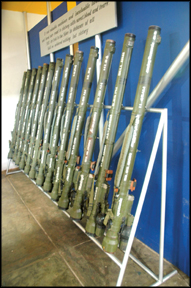 |
|
LTTE missile launchers used
against the SLAF. |
From the ‘Tiger Moth’ to the ‘Balliol’ and the ‘Auster’, from the
‘SIAI Machetti’ to ‘Pucaras’ and to jets - the wings of the Sri Lanka
Air Force that protected our skies since early ‘50s stand with solemn
pride, carrying distinctive stories representing different chapters of
the Sri Lankan aviation history at the newly opened Sri Lanka Air Force
Museum at the Ratmalana SLAF base.
Novel experience
The museum is receiving a large crowd of enthusiastic spectators
daily and on the day of our visit over 500 schoolchildren from different
schools in outstations as well as in Colombo were present. Most of the
children were from primary classes and were peeping into the cockpits,
running under the wings thoroughly enjoying and sizzling in excitement
in their marvellous world of flying machines!
Year 3 and 4 students of Dharmasena Attygala Balika Vidyalaya,
Kesbewa had visited the museum last Thursday and over 500 spectators
were visiting the museum during the morning hours alone. “Our children
may not be able to understand all that is technical but the museum is a
novel experience for them giving a different exposure as many have not
closely seen an aircraft,” an English Teacher, A.T.C. Kumari who
accompanied the little girls, told us. Another group of primary students
from the Yoshida International School in Sapugaskanda were also visiting
the museum. “My husband is an Air Force Officer and as he told me I
found it very interesting to the students,” said Hansika Perera, the
Teacher-in-Charge of the Primary section.
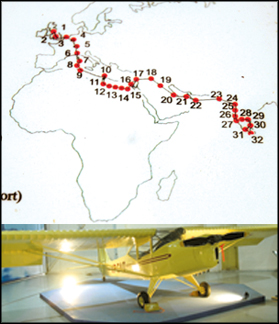 |
|
The legendary Auster and the map of
its return route |
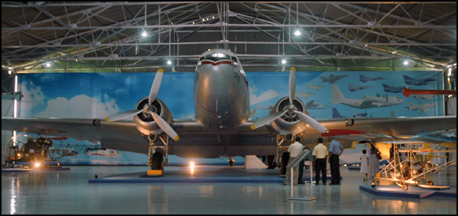 |
|
The magnificent Dakota Pix - Iresha
Waduge |
It is a gigantic source of knowledge to those who aspire to become
experts in aviation and aeronautical engineering. It is a source of
enjoyment and enthusiasm for all age groups!
The Air Force is willing to share the technical know-how in aviation
with students in the higher education stream. “We can arrange lectures
with all details, especially for students in aviation if they contact us
before hand,” Squadron Leader Rashika Jinadasa said.
Enduring airworthiness
Most of the aircraft are not just artifacts, said Commanding Officer,
Squadron Leader Malinda Perera. “They are in perfect airworthy
condition. And some aircraft are there in their original condition,” he
said. In fact, two Chipmunks, a Tiger Moth, SIAI Machetti and the
Centenary-X flew at the grand opening of the refurbished SLAF museum on
November 5.
 |
|
The Bell 47 G-2 |
The two De Havilland Chipmunk T Marks - fondly known as the Chipmunks
- were flown by Wing Commander Shehan Fernando, Commanding Officer of
the SLAF No.10 Squadron (Kfirs) and Wing Commander Dhammika Welikadapola,
a well-versed pilot of the No. 2 squadron. These aircraft, built by the
De Havilland Aircraft Company in England, were designed to succeed the
De Havilland ‘Tiger Moth’ powered by a single De Havilland Gipsy Major
series 10 MK2 engine. The Chipmunk DBH T Mark 10s were the first
aircraft purchased by the Air Force in 1951 and a total of 12 Chipmunks
were inducted.
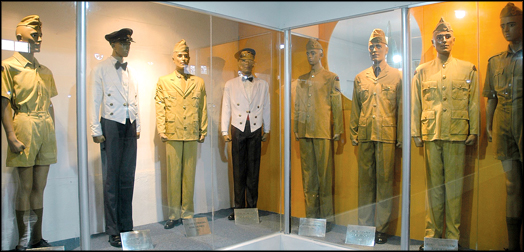 |
|
A few of the oldest uniforms worn in
1947 and early 1950s |
The single engine De Havilland DH 82, A ‘Tiger Moth’, the great oldie
of the Sri Lankan aviation history was introduced to the world in 1937.
The SLAF flew the great ‘oldie’, which is in fully airworthy condition
at the grand opening day, since her last flight in 1993. Squadron Leader
Prasanna Kuruwita, a well experienced pilot of the No. 2 Squadron flew
the Great Oldie successfully.
Flying the ‘Tiger Moth’, one of the two existing in the world in
original and airworthy condition, was a great challenge to the Air
Force. There wasn’t a single experienced pilot in the Air Force to fly
the ‘Tiger Moth’. Squadron Leader Kuruwita, who is flying the AN 32
transporting aircraft at present, found it a great challenge, yet he
studied the aircraft on his own with downloaded manuals and self
experience. “This was a very basic type of an aircraft with a limited
number of instruments, no brakes and no rear wheels, just a glider is
available to stop the moving aircraft on ground,” Sqn. Ldr. Kuruwita
said. Yet, their efforts eventually succeeded due to commitment and
dedication. “The aircraft was in perfect condition and the engine
operated smoothly,” the pilot said with great satisfaction over his
success.
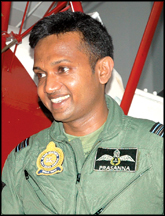 |
|
Sqaudron Leader Kuruwita thrilled over
his flight on the Great Oldie |
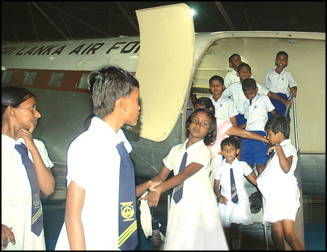 |
|
Children from Suriyawewa School
Embilipitiya, climbing down the Dakota |
The SIAI Machetti was flown by Sqn. Ldr. Tharindu Senasinghe and Sqd.
Ldr. Chandana Rathnayake at the inauguration ceremony. The SIAI Machetti
SF 260 TP is a trainer aircraft which was also used as an attack
aircraft. “This is the first aircraft to be used with armaments in the
Sri Lanka Air Force,” Sqn.Ldr. Malinda Perera, Commanding Officer of the
Museum said, referring to the history of the SLAF. They played a vital
role in providing close air support to the ground forces during the
first Eelam war. Powered by a 313 kW ‘Allison 250 - B 17 D’ Turboprop
engine, the SF 260 TPs were manufactured by SIAI Machetti and first
flown in July 1980.
The experimental ultralight aircraft, Centenary X, designed by a team
of engineering experts of the SLAF was an eye-catcher at the opening day
of the museum when Wing Commander Waruna Senaratne flew it over the
Ratmalana SLAF base. He is the pilot who flew the aircraft for the first
time in 2003.
The museum not only holds historical records of the SLAF but
preserves the golden moments of the Sri Lankan aviation history. The
Auster Mk V J/I ‘Autocrat’, a light aircraft built in England, now at
this museum made history due to the courage and determination of the
great Sri Lankan the Late James Peter Obeysekara! His flight from
Marshalls in Cambridge to Ceylon created history as the first solo
flight. Young Obeysekara faced difficulties in returning home and his
solution was to buy an aircraft and fly home.
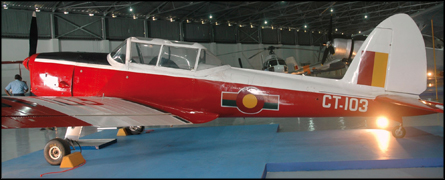 |
|
A Chipmunk on
display |
It was soon after the end of World War II and no air or sea passage
was available for civilians to travel. Starting its journey on October
5, 1946 the Auster reached Ceylon on November 13 and had 30 stopovers in
its 103 hour and 30 minute flying time including Eastleigh in
Southampton, Deanville, Le Buorget in Paris, Lyons, Nice, Tunis, Castel
Arch, Mersa Matruh, Cairo, Baghdad, Basra, Sharjah, Karachi, and
Ahmedabad to name a few.
Fighters
In later years, the Auster was handed over to the Ceylon Air Academy
and got completely destroyed on March 11, 1971 when it caught fire upon
crashing after taking off from Ratmalana airport. The SLAF accepted the
challenge in rebuilding it as a static exhibit.
From the SIAI Machettis to Pucaras and to MiGs, Kfirs and F7 - the
great warriors of our skies stand in line! The Pucaras were introduced
into the SLAF fleet in 1992 at a time when the war was at a peak.
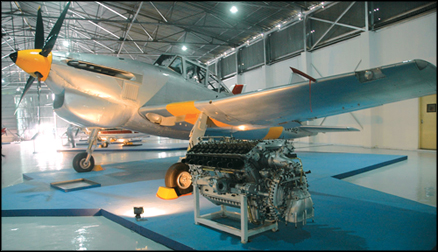 |
|
The Balliol with its
‘V’ type engine |
Named after the ancient South American ‘Inca’ Fortress by its
manufacturers, the Pucara still holds its magnificent strength and power
that dealt a severe blow to LTTE terrorism before it gained the Surface
to Air missile power.
The significance of Kfirs, MiGs and F7s in the strategy to eliminate
terrorism from this island nation forever is inestimable.
The hanger in which the aircraft are exhibited is one of the two
first built during Royal Ceylon Air Force era. They had to be removed as
the new Bandaranaike International Airprot runway was planned.
After dismantling the two, one hanger was brought to Ratmalana. The
importance of having a permanent museum as seen by the Air Force
Commander Air Chief Marshal Roshan Goonetilake was realised when the
museum was modernized after closing the old one in 2008.
The strength and the courage of our brave pilots, coupled with the
expertise and creativity of the technical and engineering staff of the
SLAF are visible in every corner of this fascinating place! Bringing
honour and pride to the motherland these ‘giants’ continue to be a
living memory to our lost warriors and the wounded. |

